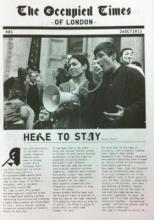How do you build a movement?
This article was written by a SolFed member and originally appeared in the "How do you build a movement?" column of the Occupied Times.
The article focuses on a practical approach to organising in which theory follows practice, is designed to appeal beyond a politicised core, and by which a movement is built by achieving concrete and escalating victories.
OT Issue 18 here.

